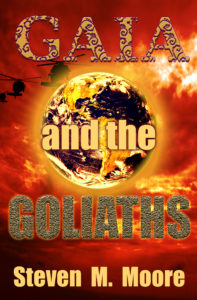Discovery…
In my novel Son of Thunder, the second book in the “Esther Brookstone Art Detective” series, a lifetime of discovery was employed. I like that term instead of research, which is used incorrectly by many authors. The historical data is already out there, even though historians hardly do research to find it either. Writers, especially authors of historical fiction, like to say they had to do a lot of “research” for their novels. Nope. They do a lot of discovery of what’s out there.
Maybe I make too much of this semantic nuance, but scientists are the ones who do real research. They collect data, and they create and test theories. As an ex-scientist, I’m qualified to state that this process greatly differs from discovering facts used in my fiction. The processes aren’t the same at all. The only thing I needed to “discover” as a scientist was whether I was duplicating something another scientist had done before. I had to discover a lot of history for Son of Thunder; I did no research.
Almost every novel I’ve written has some associated discovery time. My first, Full Medical (2006), the first book in the “Clones and Mutants Trilogy,” required a lot of discovery. I’m an ex-physicist, not a geneticist. Where did I do my discovery for that novel? In many places, digging up current facts about the cloning process (I might be wrong, but I think they’re still current, making the book into an “evergreen book”). I used the internet and articles from scientific journals; I was often led to the latter by Science News, which indicates at the end of each article where you can find more details about the subject of the article. (I’m in good company here. Isaac Asimov was a biochemist and as specialized in his discipline as much as I was in mine. He used Science News to go beyond the constraints of his discipline; so do I.)
Of course, Full Medical was a sci-fi thriller. The discovery in Son of Thunder, a mystery/thriller/suspense novel with a lot of history, has less science and more history. My discovery process goes all the way back to my teenage years when I explored other religions and began to wonder about the origins of our current Bible, which is a human cultural product no matter what religious leaders claim. About the time Dan Brown came out with The Da Vinci Code, I’d already spent years wondering about the true history of the saints, including St. John the Divine, and the Magdalene, the first female apostle. Webber and Rice’s 1971 rock opera Jesus Christ, Superstar and many works portrayed Mary Magdalene so differently, so I’d decided to discover why.
When I read The Da Vinci Code, it was a disappointment in this regard. He’d bought into a lot of historical hoaxes, for one thing. His discovery process was flawed. I like to think of Son of Thunder as The Da Vinci Code done right. Of course, my book also tries to fill in the gaps between the Crucifixion and John’s death, which makes it historical fiction. Some have even called it Christian Lit for those reasons, but, like Brown, my tale wouldn’t be sanctioned by Christian orthodoxy (although mine might have a better chance, especially by Jesuits).
Discovery to determine background material for a novel can cover the whole spectrum from easy to difficult, and its effect on the novel can cover the whole spectrum from simple to profound. Because a novel is an instrument of storytelling, the parts representing discovery have to blend in seamlessly with the fiction. The ultimate test is whether the reader can tell where the facts end and the fiction begins. I hope I’ve passed that test with all my novels, from my first, Full Medical, to the latest, Son of Thunder. Of course, your opinion might differ.
***
Comments are always welcome.

Prequel cameos. Sometimes characters from already existing novels clamor for their own…and my muses (really banshees with Tasers) listen to them! Esther Brookstone and Bastiann van Coevorden of the “Esther Brookstone Art Detective” series are examples, in this case thanks to “Detectives Chen and Castilblanco.”
Esther appeared in The Collector and Bastiann appeared in both Aristocrats and Assassins and Gaia and the Goliaths. Esther’s prequel cameo is part of the story of how stolen art can be used to finance other evil activities, in this case porn videos. Bastiann’s first prequel cameo occurs when Castilblanco, on vacation with his wife, gets involved with a terrorist who’s kidnapping European royals. His second occurs when he’s helping track down the murdering head of an energy conglomerate.
You don’t need these cameos to understand Esther’s series, but they’re evergreen books you will have fun reading. Available on Amazon and Smashwords and all the latter’s affiliated retailers (iBooks, B&N, Kobo, etc.) and library and lending services (Scribd, Overdrive, Baker & Taylor’s, Gardners, etc.). “Reading gives us someplace to go when we have to stay where we are.”—Mason Cooley.
Around the world and to the stars! In libris libertas!

July 1st, 2020 at 1:10 pm
I think you’re still a scientist, even though you are ex- in terms of what you do every day. You still have a scientist’s mindset.
I’m guilty of saying “I did research” when all I’m doing is exploring a town via Google and Maps and such, or looking into old legends about vampires and fallen angels and numerology. As faux pas’s go, I probably won’t put too much effort into trying to correct myself! 😉
July 9th, 2020 at 6:08 am
That’s OK. I forgive you. 😉 It’s all semantics…and probably a subtlety that only scientists care about.
r/Steve
To all readers: Scott is an author-friend who writes mostly far-out horror stories. Check him out.